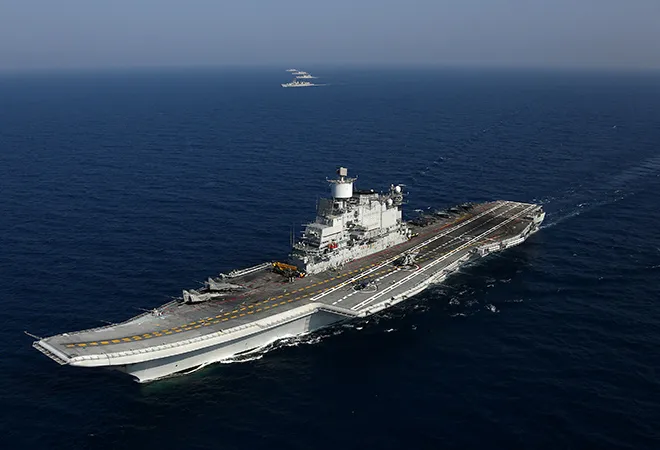
Few will argue the value of an aviation component to maritime operations — from simple transport and replenishment, to anti-ship and anti-submarine warfare, to the holy grail of full spectrum combat operations, including air defence and strikes ashore. The idea has buy-in across the navies of the world, and those that can afford it are steaming ahead, as it were, with carrier aviation.
The United States leads, with one
Gerald R Ford-class and ten
Nimitz-class supercarriers in service, along with nine smaller amphibious assault carriers (LHD/LHA type), more than all the remaining carrier-operating navies put together. In fact, some of the larger amphibious carriers themselves are similarly sized to the Indian Navy’s sole carrier, INS
Vikramaditya. The UK is next, with two brand new
Queen Elizabeth-class carriers in commission, designed around the F-35B stealth fighter and arguably the most capable carriers outside the USA. Italy also operates two carriers, the
Guiseppe Garibaldi and
Cavour, but these are far smaller vessels limited to operating AV-8B Harrier jump jets. France, India, Russia and Spain are next, each with a single carrier in service, and all of varying designs and capabilities. The French
Charles de Gaulle is by far the most potent, with steam catapults and arresting cables (
CATOBAR) to launch and recover Rafale M fighters and E-2C Hawkeye early warning aircraft. The others feature compromise in some form or another — none of them can operate radar-carrying aircraft like the Hawkeye, and while Vikramaditya is an antiquated and poorly-optimised
STOBAR design saddled with unreliable aircraft, the Spanish
Juan Carlos I is a multirole amphibious vessel that operates comparatively less effective Harrier jump jets and needs extensive downtime to switch between aviation and landing dock roles. The Russian carrier
Kuznetsov has never worked to anyone’s satisfaction, and has
suffered a long and varied of series of misfortunes that verge on the absurd. It is presently moored in Murmansk with no word on whether it can or will be returned to service.
The new entrant to the carrier game is China, which has played catch-up with remarkable speed. After refurbishing a Soviet-era
Kuznetsov-class STOBAR ship and commissioning it as
Liaoning in September 2012, the PLAN inducted an improved domestically built variant called
Shandong (also referred to as Type 001A) on 17 December 2019. While Liaoning was dedicated principally to personnel training, aircraft and equipment testing, and developing procedures and operational concepts, Shandong will be a fully operational ship meant to put the lessons learned from her older sibling into practice.
A third class of Chinese carriers is already in the works, with at least one vessel already under construction. This new class, dubbed Type 002, is of the CATOBAR configuration, and once complete will be second only to the US supercarriers in displacement — estimates put them anywhere between 75,000 and 85,000 tonnes. The ships will be conventionally powered, using integrated electric propulsion that will allow for either steam or electromagnetic aircraft catapults to be used. China is already testing both catapult types ashore at a facility in Huangdicun. Conventional power also makes the ships cheaper to build and operate. The CATOBAR configuration notably enables a much more capable air wing, including heavier fighters, drones, and
large long-range surveillance aircraft along the lines of the Hawkeye.
The PLA Navy,
currently in a period of unprecedented expansion, is not likely to have much difficulty putting together carrier battle groups around its new flattops. But even the well funded Chinese R&D and shipbuilding industries are facing issues with bringing the latest and greatest technologies to bear on aircraft carriers. Recent
reports suggest that all is not well with the planned fourth generation of carriers, intended to be true US Navy style supercarriers. China could pause its carrier programme after its two new CATOBAR ships are built. With four carriers in service, this would nevertheless leave the PLAN with the largest carrier force outside the USA.
But if China’s carrier plans are coming up against cold hard reality, what of India’s? INS
Vikramaditya is older than even
Liaoning, and is based around an inherently archaic propulsion system. Being adapted from the smaller
Kiev class has not helped its suitability to modern carrier operations either — its hangar and aircraft lifts are cramped, and its Russian aircraft launching and recovering facilities essentially limit it to operating only the MiG-29K fighter. The MiG-29K itself has been
beset by problems since it started flying from the carrier, and there is no indication that these issues have been satisfactorily resolved. With the first indigenous carrier (IAC-1) having been designed and laid down well before
Vikramaditya entered service, few lessons, if any have been applied from the Soviet carrier. As such, some early mistakes design mistakes have made it through to the final article. Most notably, although IAC-1 has optimised its hangar deck and aircraft handling with the inclusion of deck-edge aircraft lifts,
the lifts themselves are comically under-sized, restricting IAC-1 to operating only aircraft like the MiG-29K and Naval LCA. Compare this to the lifts on
Kuznetsov (and by extension the two in-service PLAN carriers), which are far larger at 15 x 14 metres. The Japanese
Izumo-class helicopter carriers were designed from the outset to be adapted for F-35B operations, and feature oversized lifts that pose no problem now that the Japanese Defence Ministry has elected to proceed with the conversion.
Similar issues dog the aircraft front, where the IN started by
abandoning the indigenous N-LCA as fundamentally unsuitable for its requirements. An
RFI for a new foreign fighter was issued in January 2017 but has not been converted into an RFP, the actual starting point of the much-maligned and glacial Indian defence procurement process. Most recently, the Navy and ADA have discarded plans for an improved N-LCA and are going to instead
develop an all new twin-engine carrier fighter to replace the MiG-29K in the long term. Although ADA has struck a positive note regarding the change, the organisation is already saddled with development of the LCA Mk.2 and AMCA for the IAF. This begs the question — why did ADA not adapt either of those programmes for the Navy’s requirement? Or, with the benefit of understanding what had gone wrong with the N-LCA in the first place, why was the AMCA not optimised from the outset to be easily adapted for carrier operations? As it stands, there appears little utility for an expensive twin-engine fourth-generation Naval fighter that will enter service, even by the most optimistic estimates, some time in the 2030s.
By virtue of their age, configuration, and air wings, it appears Indian aircraft carriers are little more than ‘carriers in being’ — able to influence adversary thought and action at sea by virtue of their very existence, but with serious questions around their actual efficacy in combat. The Navy, already operating far fewer capital ships than planned, will also have issues putting together escorting battle groups for the carriers it will operate. For the moment these are not pressing issues given that the principal naval opposition in the IOR is only the Pakistan Navy. However, a four-carrier PLAN will not be content in the Western Pacific. When full-fledged PLAN carrier battle groups with nuclear attack submarines and Type 055 destroyers begin to make their way into the IOR, the Indian Navy will be hard pressed to match them.
The obvious solution is to move forward with a CATOBAR flattop for the IN, currently
estimated at some Rs 50,000 crore (USD 7 billion) for a 50,000-tonne ship. The exorbitant cost relative to shipbuilding rates in other countries aside, a third carrier is difficult to justify when there is no clear roadmap or budgetary support for its air wing, or indeed Indian carrier aviation in general. Instead of an all-new CATOBAR ship, working out the kinks in IAC-1 and building a follow-on vessel to replace
Vikramaditya would be a cheaper exercise and still keep the nucleus of carrier aviation alive in the Navy. Rationalising carrier air wings will also be necessary. This could happen around a proven carrier aircraft along the lines of the Boeing Super Hornet or Dassault Rafale in the near term, making do with MiG-29Ks and air-defence N-LCAs in the interim. On the other hand, if a domestic solution is the priority, then it must be a more formidable fighter than what is planned — either by revisiting the AMCA or if need be designing a naval fifth-generation fighter from the outset.
The issue of not having enough capital ships to form meaningful carrier battle groups not only remains but would actually be exacerbated by tying up the capital budget in building a massive new carrier. $7 billion over a decade, on the other hand, could pay for a lot of the Navy’s more pressing deficiencies. Conventional submarines, anti-mine boats, and ASW helicopters crucial for protecting the existing carriers — all these have needed attention for the past decade, and it makes little sense to sacrifice them on the altar of the carrier.
The views expressed above belong to the author(s). ORF research and analyses now available on Telegram! Click here to access our curated content — blogs, longforms and interviews.



 Few will argue the value of an aviation component to maritime operations — from simple transport and replenishment, to anti-ship and anti-submarine warfare, to the holy grail of full spectrum combat operations, including air defence and strikes ashore. The idea has buy-in across the navies of the world, and those that can afford it are steaming ahead, as it were, with carrier aviation.
The United States leads, with one Gerald R Ford-class and ten Nimitz-class supercarriers in service, along with nine smaller amphibious assault carriers (LHD/LHA type), more than all the remaining carrier-operating navies put together. In fact, some of the larger amphibious carriers themselves are similarly sized to the Indian Navy’s sole carrier, INS Vikramaditya. The UK is next, with two brand new Queen Elizabeth-class carriers in commission, designed around the F-35B stealth fighter and arguably the most capable carriers outside the USA. Italy also operates two carriers, the Guiseppe Garibaldi and Cavour, but these are far smaller vessels limited to operating AV-8B Harrier jump jets. France, India, Russia and Spain are next, each with a single carrier in service, and all of varying designs and capabilities. The French Charles de Gaulle is by far the most potent, with steam catapults and arresting cables (
Few will argue the value of an aviation component to maritime operations — from simple transport and replenishment, to anti-ship and anti-submarine warfare, to the holy grail of full spectrum combat operations, including air defence and strikes ashore. The idea has buy-in across the navies of the world, and those that can afford it are steaming ahead, as it were, with carrier aviation.
The United States leads, with one Gerald R Ford-class and ten Nimitz-class supercarriers in service, along with nine smaller amphibious assault carriers (LHD/LHA type), more than all the remaining carrier-operating navies put together. In fact, some of the larger amphibious carriers themselves are similarly sized to the Indian Navy’s sole carrier, INS Vikramaditya. The UK is next, with two brand new Queen Elizabeth-class carriers in commission, designed around the F-35B stealth fighter and arguably the most capable carriers outside the USA. Italy also operates two carriers, the Guiseppe Garibaldi and Cavour, but these are far smaller vessels limited to operating AV-8B Harrier jump jets. France, India, Russia and Spain are next, each with a single carrier in service, and all of varying designs and capabilities. The French Charles de Gaulle is by far the most potent, with steam catapults and arresting cables ( PREV
PREV


